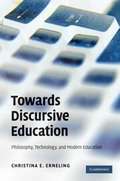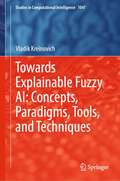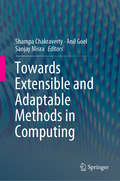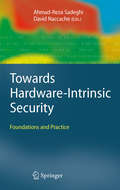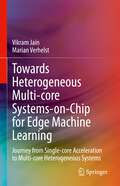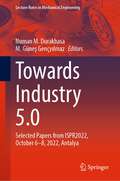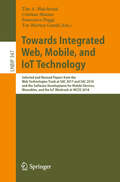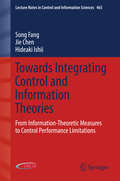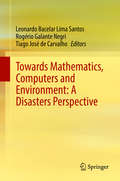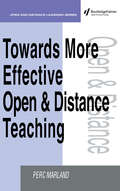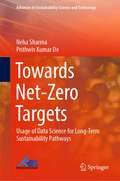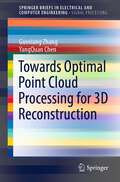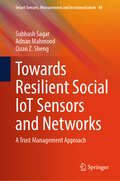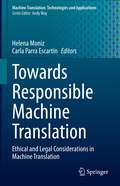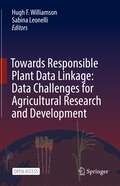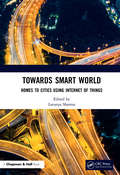- Table View
- List View
Towards Discursive Education: Philosophy, Technology, and Modern Education
by Christina E. ErnelingAs technology continues to advance, the use of computers and the Internet in educational environments has immensely increased. But just how effective has their use been in enhancing children's learning? In this thought-provoking book, Christina E. Erneling conducts a thorough investigation of scholarly journal articles on how computers and the Internet affect learning. She critiques the influential pedagogical theories informing the use of computers in schools - in particular those of Jean Piaget and 'theory of mind' psychology. Erneling introduces and argues for a discursive approach to learning based on the philosophy of Ludwig Wittgenstein and the psychology of Lev Vygotsky. This book not only addresses an urgent pedagogical problem in depth, but also challenges dominant assumptions about learning in both developmental psychology and cognitive science.
Towards Engineering Free/Libre Open Source Software (FLOSS) Ecosystems for Impact and Sustainability: Communications of NII Shonan Meetings
by Brian Fitzgerald Audris Mockus Minghui ZhouFree/libre open source software (FLOSS) ecosystems such as Linux have had a tremendous impact on computing and society and have captured the attention of businesses, researchers, and policy makers. Research on FLOSS has been ongoing for almost two decades. From an economic perspective, the most common topics involve motivation and organization. As commercial participation in FLOSS has become common, the question of how to combine FLOSS practice with commercial practice has been the subject of research, particularly with a view to understanding how to ensure sustainability of the ecosystem. This book is based on a Shonan meeting on FLOSS ecosystem sustainability held in June 2017. The meeting brought together a blend of established and young researchers who were actively studying the FLOSS phenomenon. These researchers were drawn from a variety of disciplines including software engineering, human computer interaction, information systems, computer-supported cooperative work, data mining, cognitive science, psychology, operations research, and management. Industry practitioners who were active in the FLOSS space also participated. This book presents the results of discussion on fundamental questions related to the impact and sustainability of FLOSS ecosystems, including: · How does an ecosystem form? How do different stakeholders work together to form a community that develops and maintains valuable and freely available software, and how does an ecosystem with millions of repositories and developers operate given the lack of centralized planning? · How does an ecosystem evolve in response to the environment as technology and needs evolve over time?· How do newcomers learn the protocols and practices of an ecosystem? How would they sustain the ecosystem? What is the relationship between people and ecosystem sustainability?
Towards Ethical and Socially Responsible Explainable AI: Challenges and Opportunities (Studies in Systems, Decision and Control #551)
by Anand Nayyar Mohit Kumar Mohammad Amir Akhtar"Dive deep into the evolving landscape of AI with 'Towards Ethical and Socially Responsible Explainable AI'. This transformative book explores the profound impact of AI on society, emphasizing transparency, accountability, and fairness in decision-making processes. It offers invaluable insights into creating AI systems that not only perform effectively but also uphold ethical standards and foster trust. Essential reading for technologists, policymakers, and all stakeholders invested in shaping a responsible AI future."
Towards Explainable Fuzzy AI: Concepts, Paradigms, Tools, and Techniques (Studies in Computational Intelligence #1047)
by Vladik KreinovichModern AI techniques –- especially deep learning –- provide, in many cases, very good recommendations: where a self-driving car should go, whether to give a company a loan, etc. The problem is that not all these recommendations are good -- and since deep learning provides no explanations, we cannot tell which recommendations are good. It is therefore desirable to provide natural-language explanation of the numerical AI recommendations. The need to connect natural language rules and numerical decisions is known since 1960s, when the need emerged to incorporate expert knowledge -- described by imprecise words like "small" -- into control and decision making. For this incorporation, a special "fuzzy" technique was invented, that led to many successful applications. This book described how this technique can help to make AI more explainable.The book can be recommended for students, researchers, and practitioners interested in explainable AI.
Towards Extensible and Adaptable Methods in Computing
by Sanjay Misra Shampa Chakraverty Anil GoelThis book addresses extensible and adaptable computing, a broad range of methods and techniques used to systematically tackle the future growth of systems and respond proactively and seamlessly to change. The book is divided into five main sections: Agile Software Development, Data Management, Web Intelligence, Machine Learning and Computing in Education. These sub-domains of computing work together in mutually complementary ways to build systems and applications that scale well, and which can successfully meet the demands of changing times and contexts. The topics under each track have been carefully selected to highlight certain qualitative aspects of applications and systems, such as scalability, flexibility, integration, efficiency and context awareness. The first section (Agile Software Development) includes six contributions that address related issues, including risk management, test case prioritization and tools, open source software reliability and predicting the change proneness of software. The second section (Data Management) includes discussions on myriad issues, such as extending database caches using solid-state devices, efficient data transmission, healthcare applications and data security. In turn, the third section (Machine Learning) gathers papers that investigate ML algorithms and present their specific applications such as portfolio optimization, disruption classification and outlier detection. The fourth section (Web Intelligence) covers emerging applications such as metaphor detection, language identification and sentiment analysis, and brings to the fore web security issues such as fraud detection and trust/reputation systems. In closing, the fifth section (Computing in Education) focuses on various aspects of computer-aided pedagogical methods.
Towards Hardware-Intrinsic Security
by Ahmad-Reza Sadeghi David Naccache Pim TuylsHardware-intrinsic security is a young field dealing with secure secret key storage. By generating the secret keys from the intrinsic properties of the silicon, e.g., from intrinsic Physical Unclonable Functions (PUFs), no permanent secret key storage is required anymore, and the key is only present in the device for a minimal amount of time. The field is extending to hardware-based security primitives and protocols such as block ciphers and stream ciphers entangled with the hardware, thus improving IC security. While at the application level there is a growing interest in hardware security for RFID systems and the necessary accompanying system architectures. This book brings together contributions from researchers and practitioners in academia and industry, an interdisciplinary group with backgrounds in physics, mathematics, cryptography, coding theory and processor theory. It will serve as important background material for students and practitioners, and will stimulate much further research and development.
Towards Heterogeneous Multi-core Systems-on-Chip for Edge Machine Learning: Journey from Single-core Acceleration to Multi-core Heterogeneous Systems
by Marian Verhelst Vikram JainThis book explores and motivates the need for building homogeneous and heterogeneous multi-core systems for machine learning to enable flexibility and energy-efficiency. Coverage focuses on a key aspect of the challenges of (extreme-)edge-computing, i.e., design of energy-efficient and flexible hardware architectures, and hardware-software co-optimization strategies to enable early design space exploration of hardware architectures. The authors investigate possible design solutions for building single-core specialized hardware accelerators for machine learning and motivates the need for building homogeneous and heterogeneous multi-core systems to enable flexibility and energy-efficiency. The advantages of scaling to heterogeneous multi-core systems are shown through the implementation of multiple test chips and architectural optimizations.
Towards Industry 5.0: Selected Papers from ISPR2022, October 6–8, 2022, Antalya (Lecture Notes in Mechanical Engineering)
by Numan M. Durakbasa M. Güneş GençyılmazThis book contains selected papers from International Symposium for Production Research 2022, held on October 6–9, 2022, Turkey. The book reports recent advances in production engineering and operations. It explores topics including:production research;production management; operations management;industry 4.0;industrial engineering;mechanical engineering;engineering management; andoperational research.Presenting real-life applications, case studies, and mathematical models, this book is of interest to researchers, academics, and practitioners in the field of production and operation engineering. It provides both the results of recent research and practical solutions to real-world problems.
Towards Integrated Web, Mobile, and IoT Technology: Selected and Revised Papers from the Web Technologies Track at SAC 2017 and SAC 2018, and the Software Development for Mobile Devices, Wearables, and the IoT Minitrack at HICSS 2018 (Lecture Notes in Business Information Processing #347)
by Francesco Poggi Tim A. Majchrzak Cristian Mateos Tor-Morten GrønliThis book deals with integrated Web, mobile, and IoT technologies. Novel approaches and techniques, new tools and frameworks are needed to address the increasing complexity of the distributed computing paradigms that are coming and the applications therein.This volume contains selected and extended papers from a) the Web Technologies track at the 33rd ACM/SIGAPP Symposium On Applied Computing, b) the Web Technologies track at the 32nd ACM/SIGAPP Symposium On Applied Computing, and c) the Software Development for Mobile Devices, Wearables, and the Internet-of-Things Minitrack at the 51st Hawaii International Conference on System Sciences. Overall, it provides a uniform view of cutting-edge research in Web, mobile and IoT technologies.
Towards Integrating Control and Information Theories
by Jie Chen Song Fang Hideaki IshiiThis book investigates the performance limitation issues in networked feedback systems. The fact that networked feedback systems consist of control and communication devices and systems calls for the integration of control theory and information theory. The primary contributions of this book lie in two aspects: the newly-proposed information-theoretic measures and the newly-discovered control performance limitations. We first propose a number of information notions to facilitate the analysis. Using those notions, classes of performance limitations of networked feedback systems, as well as state estimation systems, are then investigated. In general, the book presents a unique, cohesive treatment of performance limitation issues of networked feedback systems via an information-theoretic approach. This book is believed to be the first to treat the aforementioned subjects systematically and in a unified manner, offering a unique perspective differing from existing books.
Towards Intelligent Systems Modeling and Simulation: With Applications to Energy, Epidemiology and Risk Assessment (Studies in Systems, Decision and Control #383)
by Samsul Ariffin Abdul Karim Afza ShafieThis book creates the emergence of disruptive technologies that have led to a significant change in the role of mathematics and statistics for problem solving, with the use of sophisticated software and hardware in solving complex systems and process. In the era of digital technology, mathematics and statistics need to be highly relevant to be able to cater for the needs of IR4.0 such as big data analytics, simulation, autonomous system, and cloud computing. Motivated by this development, a total of 26 chapters are contributed by respectable experts for this book. The main scope of the book is to conduct a new system of modeling and simulations on solving differential equations, nonlinear equations, energy, epidemiology, and risk assessment. This book is of interest for postgraduate students, researchers as well as other scientists who are working in numerical modeling and simulations based on efficient mathematical and statistical techniques.
Towards Interoperable Research Infrastructures for Environmental and Earth Sciences: A Reference Model Guided Approach for Common Challenges (Lecture Notes in Computer Science #12003)
by Zhiming Zhao Margareta HellströmThis open access book summarises the latest developments on data management in the EU H2020 ENVRIplus project, which brought together more than 20 environmental and Earth science research infrastructures into a single community. It provides readers with a systematic overview of the common challenges faced by research infrastructures and how a ‘reference model guided’ engineering approach can be used to achieve greater interoperability among such infrastructures in the environmental and earth sciences. The 20 contributions in this book are structured in 5 parts on the design, development, deployment, operation and use of research infrastructures. Part one provides an overview of the state of the art of research infrastructure and relevant e-Infrastructure technologies, part two discusses the reference model guided engineering approach, the third part presents the software and tools developed for common data management challenges, the fourth part demonstrates the software via several use cases, and the last part discusses the sustainability and future directions.
Towards Learning and Instruction in Web 3.0: Advances in Cognitive and Educational Psychology
by Dirk Ifenthaler J. Michael Spector Kinshuk Pedro Isaias Demetrios G. SampsonTowards Learning and instruction in Web 3.0, which includes selected expanded papers from CELDA (Cognition and Exploratory Learning in the Digital Age) 2010 (http://www.celda-conf.org/) addresses the main issues concerned with evolving learning processes, innovative pedagogies, and technology-based educational applications in the digital age. The convergence of these two disciplines continues to increase and in turn, affects the academic and professional spheres in numerous ways. Towards Learning and Instruction in Web 3.0 addresses paradigms such as just-in-time learning, constructivism, student-centered learning and collaborative approaches which have emerged and are being supported by technological advancements such as simulations,virtual reality and multi-agents systems. This volume touches on both technological as well as psychological and pedagogical issues related to the developments of Web 3.0.
Towards Mathematics, Computers and Environment: A Disasters Perspective
by Leonardo Bacelar Lima Santos Rogério Galante Negri Tiago José de CarvalhoWith relevant, timely topics, this book gathers carefully selected, peer-reviewed scientific works and offers a glimpse of the state-of-the-art in disaster prevention research, with an emphasis on challenges in Latin America. Topics include studies on surface frost, an extreme meteorological event that occasionally affects parts of Argentina, Bolivia, Peru, and southern Brazil, with serious impacts on local economies; near-ground pollution concentration, which affects many industrial, overpopulated cities within Latin America; disaster risk reduction and management, which are represented by mathematical models designed to assess the potential impact of failures in complex networks; and the intricate dynamics of international armed conflicts, which can be modeled with the help of stochastic theory. The book offers a valuable resource for professors, researchers, and students from both mathematical and environmental sciences, civil defense coordinators, policymakers, and stakeholders.
Towards More Effective Open and Distance Learning Teaching (Open and Flexible Learning Series)
by Perc MarlandThis title examines the implications of personal, practical theories of distance learning for both distance learners and those who prepare distance learning materials. Case studies are used to reinforce and illustrate the arguments.
Towards Net-Zero Targets: Usage of Data Science for Long-Term Sustainability Pathways (Advances in Sustainability Science and Technology)
by Neha Sharma Prithwis Kumar DeThis book discusses the use of technology, data science and open data to achieve the net-zero carbon emissions target set up by the Paris Agreement on climate change. There have been many discussions around sustainability and climate change solutions to mitigate the negative impact. However, using technology levers to tackle climate challenges is rarely seen as the most significant catalyst. The available research in this field is generally qualitative in nature, where technology and data have not yet been leveraged. By using AI/ML, the book predicts the climate change consequences arising due to investment in fossil fuel sectors, estimates CO2 emissions from the transport sector, forecasts average land temperature due to non-renewable sources of energy, and segments Indian states on the basis of household carbon emissions. The researchers, policymakers, students, teachers, educational institutions, governments, regulators, companies, international organizations, etc., will benefit immensely by referring to this book. Moreover, the endeavour of this book is to provide a decarbonized environment and a better tomorrow to the next generation.
Towards Open and Trustworthy Digital Societies: 23rd International Conference on Asia-Pacific Digital Libraries, ICADL 2021, Virtual Event, December 1–3, 2021, Proceedings (Lecture Notes in Computer Science #13133)
by Hao-Ren Ke Chei Sian Lee Kazunari SugiyamaThis book constitutes the refereed proceedings of the 23rd International Conference on Asia-Pacific Digital Libraries, ICADL 2021, which was held in December 2021. Due to COVID-19 pandemic the conference was held virtually.The 17 full, 14 short, and 5 practice papers presented in this volume were carefully reviewed and selected from 87 submissions. The papers were organized in topical sections named: Knowledge Discovery from Digital Collections; Search for Better User Experience; Information Extraction; Multimedia; Text Classification and Matching; Data Infrastructure for Digital Libraries; Data Modeling; Neural-based Learning.
Towards Optimal Point Cloud Processing for 3D Reconstruction (SpringerBriefs in Electrical and Computer Engineering)
by YangQuan Chen Guoxiang ZhangThis SpringerBrief presents novel methods of approaching challenging problems in the reconstruction of accurate 3D models and serves as an introduction for further 3D reconstruction methods. It develops a 3D reconstruction system that produces accurate results by cascading multiple novel loop detection, sifting, and optimization methods.The authors offer a fast point cloud registration method that utilizes optimized randomness in random sample consensus for surface loop detection. The text also proposes two methods for surface-loop sifting. One is supported by a sparse-feature-based optimization graph. This graph is more robust to different scan patterns than earlier methods and can cope with tracking failure and recovery. The other is an offline algorithm that can sift loop detections based on their impact on loop optimization results and which is enabled by a dense map posterior metric for 3D reconstruction and mapping performance evaluation works without any costly ground-truth data. The methods presented in Towards Optimal Point Cloud Processing for 3D Reconstruction will be of assistance to researchers developing 3D modelling methods and to workers in the wide variety of fields that exploit such technology including metrology, geological animation and mass customization in smart manufacturing.
Towards Practical Brain-Computer Interfaces
by Anton Nijholt Brendan Z. Allison Robert Leeb Stephen Dunne José Del R. MillánBrain-computer interfaces (BCIs) are devices that enable people to communicate via thought alone. Brain signals can be directly translated into messages or commands. Until recently, these devices were used primarily to help people who could not move. However, BCIs are now becoming practical tools for a wide variety of people, in many different situations. What will BCIs in the future be like? Who will use them, and why? This book, written by many of the top BCI researchers and developers, reviews the latest progress in the different components of BCIs. Chapters also discuss practical issues in an emerging BCI enabled community. The book is intended both for professionals and for interested laypeople who are not experts in BCI research.
Towards Radical Regeneration: Design Modelling Symposium Berlin 2022
by Christoph Gengnagel Mette Ramsgaard Thomsen Olivier Baverel Giovanni Betti Mariana Popescu Jan WurmThis book reflects and expands on the current trends in the Architecture Engineering and Construction (AEC) industries to respond to the unfolding climate and biodiversity crisis. Shifting away from the traditional focus, narrowly centered on efficiency, the book presents a variety of approaches to move the AEC community from an approach that presents new challenges in all areas of the industry, from a linear, extractive paradigm to circular and regenerative one. The book presents contributions including research papers and case studies, providing a comprehensive overview of the field as well as perspectives from related disciplines, such as computer science, biology and material science. The chapter authors were invited speakers at the 8th Design Modelling Symposium “Towards Radical Regeneration”, which took place at the University of the Arts in Berlin in September 2022.
Towards Resilient Social IoT Sensors and Networks: A Trust Management Approach (Smart Sensors, Measurement and Instrumentation #48)
by Quan Z. Sheng Adnan Mahmood Subhash SagarThis book, at first, explores the evolution of the IoT to SIoT and offers a comprehensive understanding of SIoT and trust management vis-à-vis SIoT. It subsequently envisages trust quantification models by employing key SIoT-specific trust features, including SIoT relationships (e.g., friendships, working relationships, and community-of-interest), direct observations, and indirect observations, to augment the idea of trust quantification of a SIoT object. Furthermore, diverse trust aggregation techniques, i.e., conventional weighted sum, machine learning, and artificial neural networks, are proposed so as to address the challenges of the trust aggregation. Finally, the book outlines the future research directions for emphasizing the importance of trustworthiness management in the evolving notion of the SIoT.
Towards Responsible Machine Translation: Ethical and Legal Considerations in Machine Translation (Machine Translation: Technologies and Applications #4)
by Helena Moniz Carla Parra EscartínThis book is a contribution to the research community towards thinking and reflecting on what Responsible Machine Translation really means. It was conceived as an open dialogue across disciplines, from philosophy to law, with the ultimate goal of providing a wide spectrum of topics to reflect on. It covers aspects related to the development of Machine translation systems, as well as its use in different scenarios, and the societal impact that it may have. This text appeals to students and researchers in linguistics, translation, natural language processing, philosophy, and law as well as professionals working in these fields.
Towards Responsible Plant Data Linkage: Data Challenges for Agricultural Research and Development
by Sabina Leonelli Hugh F. WilliamsonThis open access book provides the first systematic overview of existing challenges and opportunities for responsible data linkage, and a cutting-edge assessment of which steps need to be taken to ensure that plant data are ethically shared and used for the benefit of ensuring global food security – one of the UN’s Sustainable Development Goals. The volume focuses on the contemporary contours of such challenges through sustained engagement with current and historical initiatives and discussion of best practices and prospective future directions for ensuring responsible plant data linkage. The volume is divided into four sections that include case studies of plant data use and linkage in the context of particular research projects, breeding programs, and historical research. It address technical challenges of data linkage in developing key tools, standards and infrastructures, and examines governance challenges of data linkage in relation to socioeconomic and environmental research and data collection. Finally, the last section addresses issues raised by new data production and linkage methods for the inclusion of agriculture’s diverse stakeholders. This book brings together leading experts in data curation, data governance and data studies from a variety of fields, including data science, plant science, agricultural research, science policy, data ethics and the philosophy, history and social studies of plant science.
Towards Smart World: Homes to Cities Using Internet of Things
by Lavanya SharmaTowards Smart World: Homes to Cities Using Internet of Things provides an overview of basic concepts from the rising of machines and communication to IoT for making cities smart, real-time applications domains, related technologies, and their possible solutions for handling relevant challenges. This book highlights the utilization of IoT for making cities smart and its underlying technologies in real-time application areas such as emergency departments, intelligent traffic systems, indoor and outdoor securities, automotive industries, environmental monitoring, business entrepreneurship, facial recognition, and motion-based object detection. Features The book covers the challenging issues related to sensors, detection, and tracking of moving objects, and solutions to handle relevant challenges. It contains the most recent research analysis in the domain of communications, signal processing, and computing sciences for facilitating smart homes, buildings, environmental conditions, and cities. It presents the readers with practical approaches and future direction for using IoT in smart cities and discusses how it deals with human dynamics, the ecosystem, and social objects and their relation. It describes the latest technological advances in IoT and visual surveillance with their implementations. This book is an ideal resource for IT professionals, researchers, undergraduate or postgraduate students, practitioners, and technology developers who are interested in gaining deeper knowledge and implementing IoT for smart cities, real-time applications areas, and technologies, and a possible set of solutions to handle relevant challenges. Dr. Lavanya Sharma is an Assistant Professor in the Amity Institute of Information Technology at Amity University UP, Noida, India. She has been a recipient of several prestigious awards during her academic career. She is an active nationally recognized researcher who has published numerous papers in her field.
Towards Solid-State Quantum Repeaters
by Kristiaan De GreveTowards Solid-State Quantum Repeaters: Ultrafast, Coherent Optical Control and Spin-Photon Entanglement in Charged InAs Quantum Dots summarizes several state-of-the-art coherent spin manipulation experiments in III-V quantum dots. Both high-fidelity optical manipulation, decoherence due to nuclear spins and the spin coherence extraction are discussed, as is the generation of entanglement between a single spin qubit and a photonic qubit. The experimental results are analyzed and discussed in the context of future quantum technologies, such as quantum repeaters. Single spins in optically active semiconductor host materials have emerged as leading candidates for quantum information processing (QIP). The quantum nature of the spin allows for encoding of stationary, memory quantum bits (qubits), and the relatively weak interaction with the host material preserves the spin coherence. On the other hand, optically active host materials permit direct interfacing with light, which can be used for all-optical qubit manipulation, and for efficiently mapping matter qubits into photonic qubits that are suited for long-distance quantum communication.
